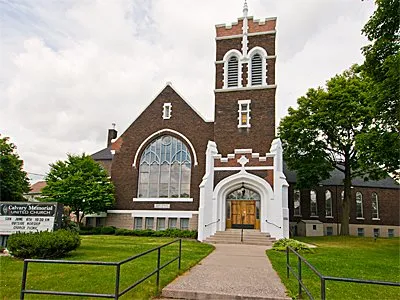The 1920s at Calvary
Following the Great War, the 1920s was an era of optimism, and it was in this spirit that construction began on Calvary Memorial Evangelical Church in August of 1921 when the first sod was turned.
The building known to us as the “little shack” was actually a family house and Zion bought it in 1919 and did the renovations necessary for it to become a temporary place for Sunday School and speaking events, although according to Calvary legend there was always a bucket handy to catch raindrops from the leaky roof.
The Mission Sunday School was formally opened in June of 1920 and the building was first used for a preaching service the next month. In 1922 there was an enrolment of 158 adults and children with 13 on the cradle roll – a number we could wish for now!
June 18, 1922 was a happy day when the rooms in the basement of the new building were opened after two and a half years of the Sunday School meeting in the “little shack’. How spacious and comfortable it must have seemed by comparison, even though the rest of the building wasn’t going to be finished for a couple of months and, of course, Kellerman Hall with several more classrooms in the basement, wouldn’t be added until 1955.
Once complete, the building cost approximately $50,000, one half of which the Jacob Kaufman family contributed. The building itself was described as constructed of chocolate bricks -- no, that’s chocolate coloured bricks with white concrete trimmings and a slate roof. The sanctuary had a seating capacity of 500.
In April of 1922, Reverend J.P. Hauch, the same minister who had first proposed in 1898 that a church be built in the North Ward of Berlin, was appointed as minister to Calvary with Reverend M.G. Geil as Associated minister. Together they ministered to both churches at first -- a definite case of multi-tasking! A year later, Reverend Geil was appointed to serve full time as minister to Calvary.
Another day of great rejoicing was September 10, 1922, with the dedication of Calvary Memorial Evangelical Church. It began with a morning service at Zion Church. A description of that service records that, quote, “The Mother Church was fully conscious of her opportunity to launch forth her young daughter with good will and best wishes.”
Afternoon and evening services followed at Calvary and at the end of the evening Bishop L.H. Seager dedicated the beautiful edifice to the glory of God as Calvary Memorial Church of Kitchener, Ontario.
Other lasting gifts to Calvary were also dedicated, given to honour the memory of loved ones by their families and friends. Included were the ten magnificent memorial stained-glass windows; the fine toned bell in the tower; and the pulpit and altar furniture in our chancel, all gifts to Calvary’s congregation, appreciated now as they were then, a hundred years ago.
All members who were received between April 1922 and April 1923 were considered charter members of the new congregation. There were 90 in all, 74 of whom transferred from Zion Church.
It’s unlikely that anyone in 1922 expected that one of those members would be alive to see Calvary turn 100; however, Mrs. Alice Goodwin Gabel, at 106 is our last Charter member. She has always liked to recall walking to Sunday School in the little shack with her mother who was among those who enthusiastically sold virtual bricks in the neighbourhood to help raise funds for the new parsonage and participated actively in the Ladies' Aid.
By the time Rev.Geil left in 1927 the Sunday School, both adults and children, had grown from under 100 to 375 and church membership had risen to 209. At that time he was honoured with, what else? a church supper and social hour! Calvary’s tradition of being a church that loves to eat was already well established.
During the 1920’s, being the only church in the area, Calvary attracted people from a wide variety of backgrounds and denominations, and developed into a community church with activities for children that, in turn, attracted their parents, many of whom were newcomers to the area looking for a church home they could walk to, since many wouldn’t have had cars then.
The 20s were a time of organization and growth and Calvary gradually evolved into an established congregation. Two major additions during this first decade were the installation of a fine pipe organ in 1924, a gift from Mrs. Mary Kaufman in honour of her husband, the late Jacob Kaufman and in 1928, the construction of the church parsonage which was made of brick that matched the church. There were also a number of firsts, including the formation of the first choir that was praised for giving excellent leadership at all three services on dedication day, the forming of an orchestra, and the publishing of the Calvary Sentinel, a monthly parish paper which reported on all church activities. In 1926 an example of the dedication of the people of Calvary was shown by the purchase of new gowns for the choir – paid for by the efforts and generosity of choir members themselves!
Soon the congregation had pleasure in recommending Mr. Wesley Siebert as a candidate for ministry. He was the first of 25 candidates for ministry who, through these 100 years, have called Calvary their home church.
It should be of no surprise that one of the first organizations to be established was the Ladies Aid which quickly became very active. Their fundraising efforts contributed financially to help the church meet its budget, which despite a steadily increasing membership, was a constant concern. Some things never change!
The decade may have begun in
an atmosphere of optimism, but it ended with the infamous crash of the stock market on October 28, 1929, that plunged the world into the Great Depression. How did that day affect Calvary? We will look at Calvary in the ‘30s next month.
